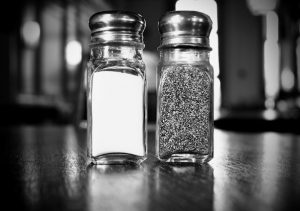
Seasoning can be thought of as putting the finishing touches to a nice outfit! The outfit looks OK without adding the jewellery or accessories but it just might not be as good! When people talk about seasoning food, it usually means adding salt and pepper, however there are lots of other herbs and spices that can also help to give an extra dimension to your favourite foods.
For a while, there was a lot of negative talk about adding salt to food. In processed food, too much salt can still sometimes be an issue (although food labelling has got a lot better), but in homemade cooking, using a little salt and pepper can help bring added flavour.
Season all the way through cooking
Seasoning isn’t just about adding some salt and pepper over the top of a plate once a meal has been cooked and plated up. It should be thought of as a layering process; food should be checked and tasted at every step during cooking. When you get familiar with doing this, the more refined your palate becomes and the better you are at identifying how much seasoning to add. Remember – you can always add more but never take it away! This is why chefs cringe at people putting salt and pepper over their food before even tasting it!
Pre-ground pepper vs whole peppercorns
Why does pepper taste so much better from a mill than the fine pre-ground pepper you buy in pots? That’s because pepper (like most other dried herbs and spices) starts to lose flavour when it’s ground, so by using your own pepper mill with whole peppercorns can make a huge difference to taste as the pepper in your food will be so much fresher.

Different types of salt
Salt doesn’t have the issue of going off, but today there is an immense variety to choose from. Each one has its own properties and is generally suited to different stages or processes of cooking but these are also subject to personal preference:
Table Salt
Table salt is ideal for general use and particularly in creating the salty water needed for cooking pasta as its smaller granules mean it dissolves quickly. Pasta water can be really salty – in Italy they say it can be as salty as sea water. Don’t be worried that all this salt will permeate your pasta – it will just give it some more flavour.
The smaller granule size also means that table salt is ideal for using in baking recipes.
Sea Salt
Granules of sea salt tend to be bigger than table salt and it is generally less processed than regular table salt, thereby retaining more trace nutrients. For this reason, it is sometimes perceived as healthier. Occasionally sea salt can have a grey look to it as it is unwashed and has had minimal processing leaving the trace elements that can cause this slight discolouration.
Himalayan Pink Salt
More recently, Himalayan Pink Salt has been marketed as containing even more trace nutrients than unrefined sea salt. This is largely unproven, although pink salt is gaining popularity in non-food uses such as health and spa treatments due to its perceived health benefits.
Fleur de Sel
An expensive, flaked salt, Fleur de Sel is sourced using very artisanal methods usually along the coastal regions of France – mainly in Brittany. The collection process by hand makes it very expensive compared to most other salts. It is not generally used as a regular salt in cooking – in most part due to cost, but is thought of more as a garnish, sprinkled over the top of desserts for example – part garnish, part flavouring!
Other methods of adding flavour
Adding lemon flavour to savoury dishes
Cooking with lemon juice or zest can give a delicious, subtle citrus flavour to simple creamy pasta and rice dishes such as risotto. If adding the juice of a lemon, this should be done during the last minute of cooking prior to serving up so the flavour remains. Lemon zest can be added slightly earlier in cooking as it retains more of its flavour however the zest should always be as fresh as possible.
Lemon also helps neutralise fats, so giving a lighter finish especially in dairy-based products.
Using herbs and spices
Most food can also be enhanced with the use of a herb or spice or two! A lot is personal preference so when cooking for others it’s wise to err on the side of caution and not go too spicy even if it would be your personal choice!
Recipes usually give exact quantities for adding herbs and spices but remember that as with salt and pepper it’s easier to add than remove. As you become more familiar with flavours you can judge quantities according to your taste.
In the majority of cases, when using dried herbs they are more concentrated and you don’t need as much of them as you do fresh ones. Sometimes the potency of herbs can be surprising and overpowering, so tasting throughout cooking is a must!
Perfect herb and food matches to try:
- Pork with sage
- Camembert and rosemary
- Lamb and mint
- Chicken with tarragon
- Tomatoes and basil (see our delicious Gazpacho recipe)
- Apples and cinnamon. Other sweet fruits such as plums or peaches also pair well with cinnamon. Try stewed fruit in winter.
- Salmon and dill and horseradish – try altogether in a sandwich
Photo 1 by Lachlan on Unsplash
Photo 2 by Josh Massey on Unsplash

